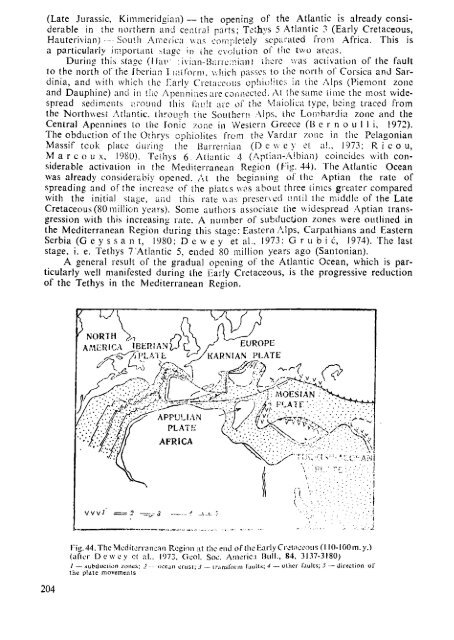THE MEDITERRANEAN LOWER CRETACEOUS
THE MEDITERRANEAN LOWER CRETACEOUS
THE MEDITERRANEAN LOWER CRETACEOUS
You also want an ePaper? Increase the reach of your titles
YUMPU automatically turns print PDFs into web optimized ePapers that Google loves.
(Late Jurassic, Kimmeridgian) — the opening of the Atlantic is already considerable<br />
in the northern and central parts; Tethys 5 Atlantic 3 (Early Cretaceous,<br />
Hauterivian; —• South America was completely separated from Africa. This is<br />
a particularly important stage in the evolution of the two areas.<br />
During this stage (ifau : ivian-Barremian) there was activation of the fault<br />
to the north of the Jberian I laiform. which passes to the north of Corsica and Sardinia,<br />
and with which the Early Cretaceous ophiolites in the Alps (Piémont zone<br />
and Dauphine) and in the Apennines are connected. At the same time the most widespread<br />
sediments around this fault arc of the Maiolica type, being traced from<br />
the Northwest Atlantic, through the Southern Alps, the Lombardia zone and the<br />
Central Apennines to the Ionic zone in Western Greece (Bernoulli, 1972).<br />
The obduction of the Othrys ophiolites from the Vardar zone in the Pelagonian<br />
Massif tcok place during the Barremian (Dewey et a!., 1973; R i с о u,<br />
M a r с о u x, 1980). Tethys 6. Atlantic 4 (Aptian-Aibian) coincides with considerable<br />
activation in the Mediterranean Region (Fig. 44). The Atlantic Ocean<br />
was already considerably opened. At the beginning of the Aptian the rate of<br />
spreading and of the increase of the plates was about three times greater compared<br />
with the initial stage, and this rate was preserved until the middle of the Late<br />
Cretaceous (80 million years). Some authors associate the widespread Aptian transgression<br />
with this increasing rate. A number of subduction zones were outlined in<br />
the Mediterranean Region during this stase: Eastern Alps, Carpathians and Eastern<br />
Serbia (G e y s s a n С 1980; D% w e y "et al., 1973; G r u b i c, 1974). The last<br />
stage, i. e. Tethys 7'Atlantic 5, ended 80 million years ago (Santonian).<br />
A general result of the gradual opening of the Atlantic Ocean, which is particularly<br />
well manifested during the Early Cretaceous, is the progressive reduction<br />
of the Tethys in the Mediterranean Region.<br />
204<br />
big. 44. The Mediterranean Region at the end of the Early Cretaceous (110-100 m.y.)<br />
(after Dewey cl al.. 1973, Gcol. Soe. Ameiic.i Bull., 84, 3137-3180)<br />
1 — subduction /ones; 2 -• ocean crust; J — transform faults; '/ — other faults; J — direction of<br />
the plate movements

















